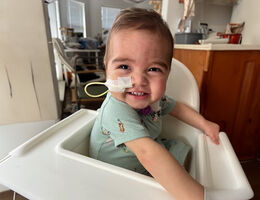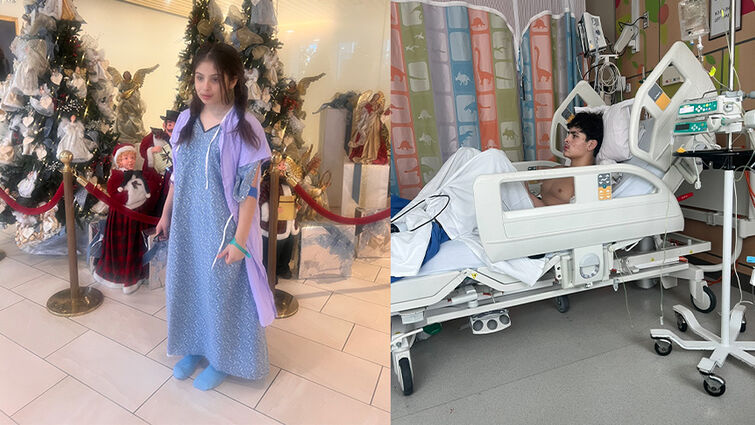

Sophia Grace Moreno and Marcos Nava during their time at Loma Linda University Children’s Hospital
It started with high fevers and body aches. On her 12th birthday, Sophia Grace Moreno was bedridden, covered in bruises, and unable to walk. For months, no one could figure out what was wrong.
"They said it was pneumonia. Then they said it was a virus. Nothing was working," her mother, Veronica Moreno, said. But when a pediatric specialist at Loma Linda University Children's Hospital finally diagnosed Sophia with Valley fever, everything changed.
"I had never even heard of it," Moreno said. "We don't live in a farm town. We live in Corona."
Sophia's diagnosis was followed by a long treatment plan: daily eight-hour antifungal infusions, lumbar punctures, CT scans, MRIs, and ongoing therapy for nerve damage and anxiety. Now, she's on medication that she may have to take for the rest of her life. Her once-vibrant personality, a girl who loved dancing, sports, and flag football, has shifted dramatically.
"She's not the same. She's withdrawn. She's tired. Her hair is falling out. And the pain doesn't go away," her mom said.
Valley fever, or coccidioidomycosis, is caused by inhaling a fungal spore that lives in dirt and dust. While often associated with rural or construction communities, Alvaro Galvis, MD, PhD, a pediatric infectious disease specialist at Loma Linda University Children's Hospital, says that this is changing.
"We're seeing an increasing number of pediatric cases here in Southern California, including places like Barstow, Corona, and Riverside," said Galvis. Loma Linda University Children's Hospital is seeing around three cases per month this year, compared to less than one case per month in previous years, according to Galvis.
The illness doesn't spread from person to person. It begins subtly with fatigue, cough, and muscle aches, often mimicking the flu or a severe cold. That's why it's easy to miss until it becomes serious.
Marcos Nava, a 17-year-old from Barstow, had a similar experience. A competitive high school wrestler, Marcos first experienced shortness of breath a year ago. At first, a Barstow hospital suspected Valley fever, but a follow-up doctor said it wasn't active. A year later, over Easter, his condition worsened, and his lung partially collapsed. He was hospitalized for nearly a month.
"The lesion on his lung went from two centimeters to three. No one warned us to look out for anything," said his mother, Stacy Santerelli. "Now we know. But we had to learn the hard way."
Marcos is recovering and slowly returning to the wrestling ring. "People don't think it's a big deal until it happens to them," Santerelli said. "I didn't know my son could nearly lose a lung from something that looks like a cold."
Sophia is still in treatment. Her mother says the illness has reshaped their entire lives, emotionally, physically, and financially. She hopes that by speaking out, more families will recognize the warning signs and take action early.
California has reported nearly 5,000 Valley fever cases since January of 2025, according to the California Department of Health, but many more likely go undiagnosed. Conditions like wildfires, drought, and intense wind events disturb the soil, sending fungal spores airborne, boosting transmission.
Both mothers urge parents to advocate fiercely for their children.
"I pushed every day," Sophia's mom said. "I called doctors constantly. I messaged them when something didn't seem right. If I hadn't, I don't know if she would be here."
They want more people to be aware of Valley fever. To ask for the blood test. To not ignore persistent symptoms. To realize it can happen even in suburban neighborhoods, with no farms or visible dust.
"You could just be outside breathing," Sophia's mother said. "That's all it takes. Valley fever changed everything for us. But if more people knew, maybe it wouldn't have to."
Galvis’ tips for parents
Parents and doctors, especially those in inland or wildfire‑prone regions, should consider Valley fever when symptoms (fever, persistent cough, chest pain) last more than two weeks or don’t respond to antibiotics.
A blood test for Coccidioides can help confirm the diagnosis. Request one if symptoms linger.
Wearing N95 masks during wildfire events or while exposed to dust during construction or yard work lowers risk, especially for vulnerable groups.
Early detection allows for effective antifungal therapy, preventing complications like lung lesions, systemic spread, or even death.
For more information, schedule an appointment with your child’s primary care provider today.



